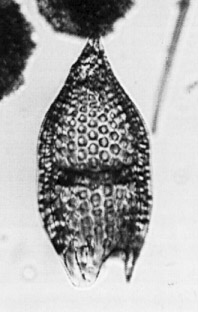 Podocyrtis
(Podocyrtoges) diamesa Riedel and Sanfilippo
Podocyrtis
(Podocyrtoges) diamesa Riedel and Sanfilippo Podocyrtis
(Podocyrtoges) diamesa Riedel and Sanfilippo
Podocyrtis
(Podocyrtoges) diamesa Riedel and SanfilippoPodocyrtis (Podocyrtis) diamesa Riedel and Sanfilippo, 1970, p.533 (pars), pl.12, fig.4, non figs.5-6; Sanfilippo and Riedel, 1973, p.531, pl.20, figs.9-10, pl.35, figs.10-11
Podocyrtis (Podocyrtoges) diamesa Sanfilippo and Riedel, 1992, p.14
Cephalis elongate-hemispherical, with small pores, bearing a horn of variable length, which is bladed in early specimens, conical and robust in late specimens. Collar stricture marked by change in contour. Thorax inflated-conical, with pores circular and in longitudinal rows separated by ridges in early specimens, larger and lacking intervening ridges in late specimens. Thorax and abdomen of variable proportions, but often of approximately the same length. Slight lumbar stricture. Abdomen tapering distally, sometimes slightly inflated. Abdominal pores subcircular in longitudinal rows, in early specimens similar in size to distal thoracic pores and separated by longitudinal ridges, in later specimens larger and lacking longitudinal ridges. Three feet shovel-shaped (Riedel and Sanfilippo, 1970).
Length of thorax 140-160 µm; total length (excluding horn) 220-390 µm; maximum breadth 130-180 µm.
Podocyrtis (P.) diamesa differs from P. (Podocyrtis) papalis in its larger size and the presence of a slight lumbar stricture, from P. (P.) phyxis by the presence of longitudinal ribs between pore rows and the pores being smaller, from P. (P.) ampla in its general form being spindle-shaped rather than conical, and from P. (P.) dorus by not having a strongly constricted mouth (Sanfilippo et al., 1985).
Horn in early specimens short and bladed, in late specimens conical and robust. Thorax and abdomen of variable proportions, but often of approximately the same length. Slight lumbar stricture. Abdomen tapering distally, sometimes inflated. Thoracic and abdominal pores circular to subcircular in longitudinal rows, in early specimens separated by distinct longitudinal ridges, in late specimens larger, with less distinct ridges (Sanfilippo et al., 1985).
This species occurs in low-latitude samples of late early Eocene to middle middle Eocene age, including DSDP Site 10 at about 30°N in the Atlantic. Its morphotypic first appearance lies within the Phormocyrtis striata striata Zone. Its evolutionary transition to Podocyrtis phyxis lies within the Thyrsocyrtis triacantha Zone.
P. (P.) diamesa is the intermediate form between P. (Podocyrtis) papalis and P. (P.) phyxis in the evolutionary lineage leading to P. (P.) ampla. P. (P.) dorus and P. (P.) platypus are off-shoots from this evolutionary line at about the level of occurrence of P. (P.) diamesa.